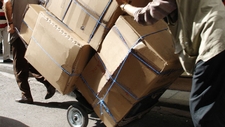Changes in Motion: Push and Pull
Supporting

TEKS Objective
The student is expected to demonstrate and observe how position and motion can be changed by pushing and pulling objects to show work being done such as swings, balls, pulleys, and wagons.
Essential Understanding
The student knows that forces cause change and that energy exists in many forms.
Science Background
Rockets, Force and Motion: K8 Science (video) – A force is a push or a pull that can change an object’s motion. Dr. Greg Vogt uses rockets to explain force and motion.
Rockets, Force and Motion
by Greg Vogt, BioEd Online, www.bioedonline.org
Newton’s Laws of Motion: NASA Goddard Space Flight Center (website) - Details about Newton’s laws and their applications.
Newton’s Laws of Motion
by David P. Stern, NASA Goddard Space Flight Center, www-istp.gsfc.nasa.gov
The Force Be with You! Prince Edward Island (CA) Department of Education and Early Childhood Development (website) - Introduction to the concept of force, different types of force, the effects of different forces on Earth, and related topics. Content is appropriate for teachers and/or students.
Force Affects Motion: School for Champions (website) - Concise explanation of how force affects motion, with reference to push, pull, gravity, friction and magnetism.
Force Affects Motion
School for Champions, www.school-for-champions.com
Signature Lesson
Pop Can Hero Engine: NASA Rockets Educator Guide (PDF / Video) - Students make a Hero engine from a pop can and then demonstrate and observe how the forces of action and reaction produced by falling water cause the “engine” to rotate. The lesson mentions Newton’s Third Law as the objective, but it addresses TEKS 3.6B. Lead a class discussion about the forces that make the can rotate, and ask students if “push” or “pull” forces are making the can move. Students make a Hero engine from a pop can and then cause the “engine” to rotate with the forces of action and reaction produced by falling water.
Pop Can Hero Engine
BioEd Online, www.bioedonline.org
Pop Can Hero Engine
NASA Rockets Educator Guide, www.nasa.gov
- Supporting Lessons
- Extensions
- Assessment Ideas
- Literature Connections
- Related
TEKS - Additional Resources
Supporting Lessons
3… 2… 1… Puff! NASA Rockets Educator Guide (PDF) - Build and launch simple paper rockets, and then lead a class discussion about the forces that help the paper rockets to fly.Build and launch simple paper rockets.
3… 2… 1… Puff!
NASA Rockets Educator Guide, www.nasa.gov
Pulleys and Force: TryEngineering (website) - Students learn about different uses for pulleys, the impact of multiple pulleys, and identify pulley use in school and their community.
Elaboration Lessons and Extensions
Rockets Educator Guide: NASA (website) – Complete guide with activities on force and motion.
Rockets Educator Guide
NASA, www.nasa.gov
Newton Laws of Motion: Seaworld/Busch Gardens (PDF) - Students observe animal behaviors as examples of force and motion.
Newton Laws of Motion
Seaworld/Busch Gardens, www.seaworld.org
Spoonapult: The Tech Museum (PDF) - Students construct a small catapult from craft sticks, rubber bands and a plastic spoon to explore forces and motion.
Assessment Ideas
Challenge students to devise as many ways as possible to move a heavy object (thick book) from one place to another. Provide different materials for students to use, such as a wagon, pulleys, wheels, tubes, string, sticks, etc.
Literature Connections
Forces and Motion: From High-speed Jets to Wind-up Toys. DeRosa, T., Reeves, C. (ISBN-13: 978-0890515402)
A Crash Course in Forces and Motion with Max Axiom, Super Scientist. Sohn, Emily (ISBN-13: 978-0736868372)
Isaac Newton and the Laws of Motion. Gianopoulo, Andrea (ISBN-13: 978-0736868471)
And Everybody Shouted, “Pull!” Llewellyn, Claire (ISBN-13: 978-1404806566)
Motion: Push and Pull, Fast and Slow. Stille, Darlene (ISBN-13: 978-1404803480)
Additional Resources
Forces and Magnets: Science Zone (website) – Basic facts about forces, with links to interactive animations and games that teach students different concepts related to force.
Forces and Magnets
Science Zone, primaryhomeworkhelp.co.uk
Force: Songs for Teaching (website) - Have fun teaching about forces by leading the class in a “sing-along.”
TEKS Navigation
Grade 3
Need Assistance?
If you need help or have a question please use the links below to help resolve your problem.

Comments
At first glance this content appears to be advanced for third grade